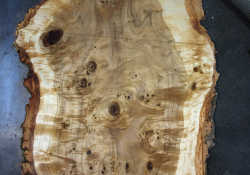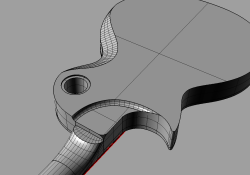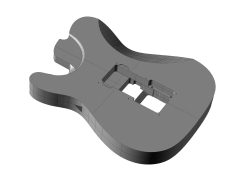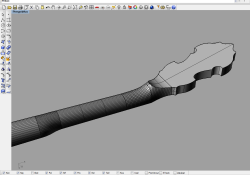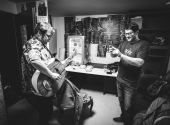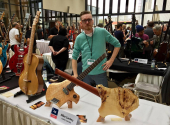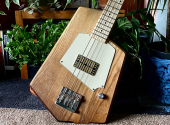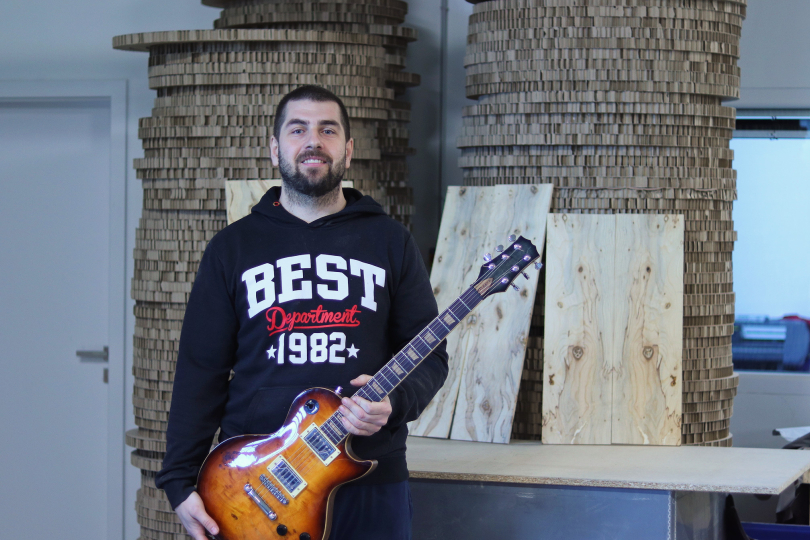
Dreamstruments #28: Carpathian Guitars
Not only the ways of the Lord, but also those of the guitar makers can sometimes be rather mysterious. Milan aka Mulen Zelenka is a perfect example of how it is possible to leave guitar making, start doing accounting, aeromodelling, making furniture and mirrors and then go back to guitar making again. So let's take off for an exciting journey to Slovakia together with Carpathian guitars.
Back in the old days, when specialized discussion forums still existed, I came across a skilful young guy Mulen posting his guitar creations on the Slovak portal gitaristi.sk. From the beginning, the surprisingly high level of his craft was clearly recognizable, confirmed by the references of satisfied customers.
The road to them was rather tortuous. Mulen didn't enjoy working in an accountancy firm (although he still keeps his own books to this day). He enjoyed aeromodelling (apart from the tedious production itself), so he looked for ways to make it as simple as possible. In his search, he came across an English CNC forum where he learned basic information about controlling, programming, 3D drawing and building his own CNC (computer numerically controlled) machine tool. He boldly set out to follow his new dream, ordered the necessary parts and built his first "CNC" in his parents' basement.
I am shocked to note that Mulen did all this without any deep knowledge of English, using only google translator! A clear proof that where there is a will, there is a way. By the way, this first machine is still working to the satisfaction of a modeller from Prague to whom Mulen sold it long ago. Music came into his life and while playing Metallica or AC/DC he thought to use his experience with automatic woodworking and build a proper guitar. It was so successful that a bandmate promptly bought it from him. So Mulen built another model – and again there was a taker. Then another... and history began to repeat itself in such a way (someone always bought his guitar) that Mulen decided to try making guitars full-time under the Mulen guitars brand.
Gradually more and more improved CNC machines, experience and guitars were added. Mulen complained that there was no comprehensive information on wood machining (as opposed to, say, metal), so enthusiasts had to discover everything by trial and error. Every wood has different properties and you really can't just draw something and run a furious milling machine to cut it. I know it well from the production of ceramic instruments when Mr Pavlinec had to develop working methods to process hard but fragile ceramics.
Fortunately, the CNC community is open and people have no problem sharing information and helping each other. Meanwhile, the invisible hand of the market has dryly solved the debate about whether the use of CNC technology in guitar making is correct or not, and these machines are now commonly purchased by individuals for their workshops (see for example Wolf Guitars). If someone wants to waste time hand-roughening material today, then they can probably ask for adequately high prices. Other luthiers like to optimize their production and then spend their time on things that machines can't yet do, so the human hand, eye and experience are still irreplaceable.
Mulen MG3
From these pioneering times comes my variation on the Stratocaster, inspired by the interesting PRS DC3. Indeed, I've always been visually somewhat unnerved by the slanted bridge pickup on Strats (there is no real reason for the slant position nowadays, apart from tradition), so I welcomed the fact that the respectable Paul Reed Smith dared to get rid of this idol after half a decade – though of course he wasn't entirely alone, let's remember for example the iconic Brian May Red Special.
It was a new experience for me, as we had first tuned the instrument using 3D modelling. I could make up all sorts of details, which Mulen immediately captured in the drawing. I wanted the guitar unpainted, so only beeswax is used as a finish and the instrument is beautifully satiny to the touch. I don't have an aggressive sweat and I haven't played it live, so it was doable. However, in hindsight, I consider this lore (that unpainted guitars play better) to be more of a legend fueled by the lesser availability of such instruments.
The pickups I chose were GFS 1959 Vintage Wound Professional Series, with materials and technology close to the old vintage pieces – at least according to the descriptions on the web... I got an excellent Strat-like guitar to my specifications, with additional tweaks such as two Tom Anderson Guitarworks-style rear belt knobs (making the leaning guitar much more stable), a waxed alder body, and a one-piece maple neck and fretboard with custom position markers.
We struggled a bit with the tremolo – only on the second try we made it with a better quality German ABM. Note: Don't buy the cheap Chinese fake mechanical hardware made of ABS ("Asian butter steel"). The tremolo edge was blunt after a few hours of playing and it was desperately out of tune.
Mulen MM hybrid
A fancy custom order for a very demanding customer (Milan's guitar teacher) who was looking for a high-end custom instrument but wasn't satisfied with a tried-and-tested homemade one. It was only when he was playing more and more Mulen guitars that he decided to give it another try, and to this day he has no regrets. His dear Musicman was abandoned shortly after getting this Telecaster on steroids.
Mahogany body with a gorgeous maple top, maple neck with rosewood fretboard and upgraded bracing. DiMarzio pickups are complemented by a Graphtech Ghost piezo bridge. Said to be by far the most complex circuit Mulen has ever made. But from the sound of it, it paid off and the discerning customer is satisfied with a wide range of sounds complemented by the convincing stage sound of an acoustic guitar.
So everything was lovely and positive until the COVID time came along. Playing stopped and so did the orders. Even guitar makers have to pay their mortgages, so Milan had to close up his shop and make a living as a cabinetmaker for a few years. To my surprise, he called it the most thankless job under the sun. Mostly because of the customized installations, which can turn into nightmares full of unpaid overtime hours due to crooked ceilings, walls and floors.
Fortunately, other companions had a dream to start making guitars and had many other exciting plans. They got a hall and a new era began for Milan. Since he was no longer alone and the name of Mullen had been taken by the American Mullen (steel guitars), they decided to rename the company to Carpathian guitars. Because one of the main hallmarks from now on will be the massive use of local woods from the Carpathians. They also started an e-shop with guitar parts TESLA strings, where they stocked a large stock of Gotoh parts because otherwise, the waiting time for this Japanese quality in Europe is usually many months.
Mulen Les Paul
One of the last Mulen Les Pauls is Milan's personal Les Paul, which is a dream come true for his love of Guns N'Roses and Slash. It's a really solid piece of resonant walnut with a fancy poplar burl top.
The walnut neck is interspersed with maple, the binding is made of European curly maple, and the subtly milled heel eases access to the higher positions. The headstock, whose final shape was voted by fans on Facebook, is tapered for straighter string routing. He's very happy with the Fishman Fluence Classic active pickups, which are very dynamic, and with three equalization modes, so the sonic nuances are almost endless. And, of course, there's no shortage of proven Gotoh hardware.
Carpathian Guitars have a lot of ideas, which they kept me introduced to throughout the whole intense day. From the aforementioned Carpathian woods, where mountain cherry, for example, is a tree with a long straight trunk providing lots of beautiful material, to poplar and ash burl, chestnut, plum and birch with beautiful grain, to sorb apple tree, one of the hardest European woods suitable for fretboards. Upcoming series with tantalising names like Bathory, Čachtice, Carpathian wood and Vladicaster (I probably don't need to suggest which Dracula they have in mind). Production of custom pickups and guitar electronics. I was very interested in the lecture about natural dyes like medieval black oak ink (Bathory Black), and I'm looking forward to a shade of blood cherry red or venomous absinthe green! They are also preparing a video series of tutorials for guitar makers, which will be freely available.
So anyone who would like to make their dreams come true, perhaps with beautiful local woods, do not hesitate to contact Carpathian guitars. I've already ordered a rather wild piece myself...
If you have found an error or typo in the article, please let us know by e-mail info@insounder.org.

